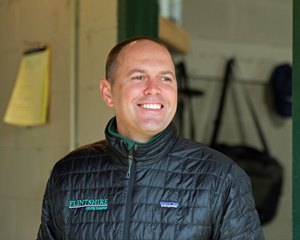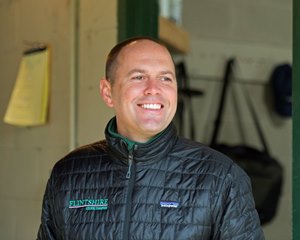Brown Has Reason to Smile Heading Into Kentucky Derby


The sound of a few interested parties walking up to Churchill Downs' Barn 42 catches trainer Chad Brown's attention the morning of April 25. As he watches their eyes scan his shedrow for the white-blazed face of the chestnut colt who skipped over the track about an hour earlier, he graciously lets the visitors know all continues to be well in the world that surrounds reigning juvenile male champion Good Magic.
Brown doesn't just leave it at that, though. In addition to discussing the horse who will attempt to give his powerhouse barn the first leg of the Triple Crown May 5, he indulges in easy small talk about everything from morning training activities to the joy of finding the photographer who shot a treasured photo of his younger self at the end of the shank of multiple grade 1 winner Tates Creek, back when he was just the quiet, studious assistant to Hall of Famer Bobby Frankel.
The entire time he converses, a broad grin on Brown's face barely dips—something he is aware enough to point out.
"Everyone says I never smile," he cracks, referencing one of the preconceived notions about himself that has prompted some ribbing among his peers.
When you win back-to-back Eclipse Awards as the nation's outstanding trainer before the age of 40, people are going to talk about you—good, bad, or indifferent. And when it comes to the runners under Brown's care, there is never a shortage of material to discuss—not with champions on top of champions swarming the sport like a posse with endless reinforcements.
In addition to his sometimes intense demeanor, one of the other theories Brown has heard about himself in recent years is that his skill set was limited to turf runners.
Like the smile that has been a regular part of his visage in recent weeks—inspired in no small part by the continued progression of the horse who still holds divisional bragging rights—Brown is all too happy to keep providing ample evidence to the contrary.
♦♦♦♦♦♦♦♦♦♦
A true measure of success is not just reaching a peak, it's adapting to the altitude in order to remain there for the long term. Over the past couple seasons, Brown's operation has silenced those who doubted its ability to be an all-encompassing juggernaut by putting some of the sport's most significant dirt prizes on a mantel already packed with Breeders' Cup and Eclipse Award trophies.
Since the time he went out on his own in 2007, the 39-year-old Brown has been a bit of a wunderkind. A year into his career, he saddled his first Breeders' Cup winner when Maram took the 2008 Grey Goose Juvenile Fillies Turf. From there, an endless procession of grass standouts followed—from champions Stacelita and Zagora, to Lady Eli and Flintshire , to current darlings Rushing Fall and Analyze It.
While it didn't necessarily irk Brown to be recognized for his undeniably deft hand with developing grass talent, what did bother the native of Mechanicville, N.Y., was the sentiment that his ability was one-dimensional. As he joked shortly after saddling his first classic winner last year when Cloud Computing captured the Preakness Stakes (G1), it's not like he turned his head while assisting his late mentor Frankel when the dirt runners came out to train.
"Bothered me wouldn't be the right word. It was frustrating at times," Brown said of being labeled "just" a turf trainer. "If I hear that, it doesn't really upset me. The only thing that upsets me or bothers me is if a statement like that, or a thought like that, leads to us getting less opportunities with dirt horses. Then I'd say it's not fair, because it's not true. But in fairness to people who might have that misguided opinion, we have been extremely dominant on the turf ... so it's a natural feeling to maybe think, 'Hey, this is their primary focus.'"
Beginning with Wavell Avenue's victory in the 2015 TwinSpires Breeders' Cup Filly & Mare Sprint (G1), the full breadth of Brown's aptitude began to testify on its own behalf. Among the victories that preceded his Preakness triumph were top-level wins in the 2016 Hopeful Stakes (G1), Champagne Stakes (G1), and Cigar Mile Handicap (G1). And by the time 2017 concluded, he had the winter-book favorite for the Kentucky Derby Presented by Woodford Reserve (G1) in his barn as a result of Good Magic's emphatic victory in the Sentient Jet Breeders' Cup Juvenile (G1).
For those who may call the underside of a rock home, the last few weeks have served as a microcosm of how proficient the Brown barn has become across the board. He racked up four graded stakes wins during the Keeneland spring meet alone, highlighted by Good Magic's 1 1/2-length triumph in the Toyota Blue Grass Stakes (G2). He's still the kingpin of the turf, as evidenced by his 1-2-3 sweep of the April 14 Coolmore Jenny Wiley Stakes (G1T), but the days of any top-level test being safe from his grasp have gone by the wayside.
"If you took away all the turf races, and you just put your hand over it and only looked at the dirt races we've won—our team—that in itself would be a lifetime career for most trainers," Brown said. "And I take a lot of pride in that to say that.
"We don't go around throwing around what we've won, but at the same time, if I'm being considered for some opportunities, it's like, go look at the races we've won already. Every year I've seen us getting more and more opportunities and ... since last year's two big accomplishments on dirt with males, I've seen again another increase in opportunities that we're getting this year, with this next crop coming in. I'm happy more and more clients are recognizing this."
Brown's Cornell-educated mind thrives off details and competitive challenges. His ability to place horses in the right spots is virtually without peer. Whether it's a shoeing change, a shift in workmates, or simply more time, Brown is a borderline savant when it comes to pinpointing what tweaks it takes to keep his protégés progressing.
His proclivity toward turf runners was brought on in large part by clients like Martin Schwartz and Juddmonte Farms, who sent him European horses over the years to try against stateside competition. Those who have watched him absorb the lessons offered and morph them into his own philosophies, however, say only the foolish would try and put a ceiling on what Brown could achieve.
"I really believe that Chad is the best trainer in America," said owner Ken Ramsey, who was among the first to give Brown horses when he started out and is still proud of the fact it was his former claimer, Dual Jewels, who went into the books as Brown's first winner. "When he was starting out, I used to advise him—say, we ought to ride this jockey, this one would be better on the turf or dirt—all that kind of stuff. Now I take a backseat to him, because I'm actually in awe of what he's accomplished.
"He sets a goal and he works backwards from it. He'll plan two or three races up to the race that is the goal, and it doesn't always work out that way, but he'll always have a plan A and a plan B. He's on top of his game and he's going to stay on top."
♦♦♦♦♦♦♦♦♦♦
When owner Bob Edwards of e Five Racing got involved in the Thoroughbred business three years ago, he was encouraged to have Brown as part of the team charged with producing results for the fledgling operation. Within a year, the pharmaceutical executive became the latest to be gobsmacked by the level at which Brown delivers, when his filly New Money Honey captured the 2016 Breeders' Cup Juvenile Fillies Turf (G1T).
As the owner of Rushing Fall, winner of the 2017 Juvenile Fillies Turf, and co-owner of Good Magic along with Stonestreet Stables, Edwards has admittedly had a dream foray into the industry courtesy of Brown and his team. Three Breeders' Cup wins and a Derby contender is a haul in such a short period of time, but Edwards says one of the perks of being part of a racing super group is getting unfiltered access to the frontman who makes the end result of a 24/7 grind look seamless.
"He has this squint— it's that facial impression ... with that kind of one eye open, one eye kind of closed look—that's him thinking," Edwards said of Brown. "I know him well enough that when I see that look, the wheels are turning and the processor is kicking into high speed. I've seen him do that 100 times and look at a horse and say, 'This one needs a few more days. I'm still not happy with them. Who shod that horse? I don't like this. Let's get them back here.' He's just on top of everything.
"I get Chad, because I was Chad at Chad's age. I had early success in pharma, so I understand the pressures and sacrifices you make to be successful at a certain level. Obviously, if you win three Breeders' Cups together and an Eclipse Award, we have a lot of business interests. But we've become quite good friends over the years."
The more Brown wins, the more evidence he stockpiles in a case that looks like it will eventually culminate with his joining Frankel in the Hall of Fame, the more he is going to have to say to those who have formed all manners of opinions about him.
In each of his Eclipse Award speeches for outstanding trainer the last two years, Brown has made it a point to go name by name thanking every member of his staff, from assistants to his bookkeeper. It drives the show producers crazy in their often-futile quest to bring the event in under three hours.
"The best thing about winning an Eclipse Award is not the trophy. It's not all the accolades you get personally. It has nothing to do with that. The very best part about winning that award is that five minutes it gives you to thank everybody," he said. "For me, I'm driven to try and win this again sometime in my life, I hope, because I want that five minutes again. Because every time I walk off that stage, I forget somebody."
His goal, he says, is to get that speech up to a half hour. When told of the amount of time afforded to the connections of Kentucky Derby winners, Brown did what he has been doing much of these days.
He smiled.
